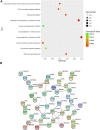Identification of copy number variants contributing to hallux valgus
- PMID: 37035746
- PMCID: PMC10076598
- DOI: 10.3389/fgene.2023.1116284
Identification of copy number variants contributing to hallux valgus
Abstract
Hallux valgus is a common form of foot deformity, and genetic factors contribute substantially to the pathogenesis of hallux valgus deformity. We conducted a genetic study on the structural variants underlying familial hallux valgus using whole exome sequencing approach. Twenty individuals from five hallux valgus families and two sporadic cases were included in this study. A total of 372 copy number variations were found and passed quality control filtering. Among them, 43 were only present in cases but not in controls or healthy individuals in the database of genomic variants. The genes covered by these copy number variations were enriched in gene sets related to immune signaling pathway, and cytochrome P450 metabolism. The hereditary CNVs demonstrate a dominant inheritance pattern. Two candidate pathogenic CNVs were further validated by quantitative-PCR. This study suggests that hallux valgus is a degenerative joint disease involving the dysregulation of immune and metabolism signaling pathways.
Keywords: copy number variation; cytochrome p450 metabolism; hallux valgus; immune dysregulation; whole exome sequencing.
Copyright © 2023 Zhou, Jia, Qu, Ma, Li, Qi, Meng, Ding, Zheng, Hakonarson, Zeng, Li and Xia.
Conflict of interest statement
ZD is an employee of Fynn Biotechnologies Ltd. The remaining authors declare no conflicts of interests and no competing interests of this work. The funders had no role in the design of the study; in the collection, analyses, or interpretation of data; in the writing of the manuscript, or in the decision to publish the results.
Figures




Similar articles
-
New insights into hallux valgus by whole exome sequencing study.Exp Biol Med (Maywood). 2021 Jul;246(14):1607-1616. doi: 10.1177/15353702211008641. Epub 2021 Apr 29. Exp Biol Med (Maywood). 2021. PMID: 33926255 Free PMC article.
-
Hallux valgus: demographics, etiology, and radiographic assessment.Foot Ankle Int. 2007 Jul;28(7):759-77. doi: 10.3113/FAI.2007.0759. Foot Ankle Int. 2007. PMID: 17666168
-
Correlation analysis between vitamin D receptor gene polymorphism (BsmI) and hallux valgus.J Biol Regul Homeost Agents. 2020 Jul-Aug,;34(4):1343-1353. doi: 10.23812/20-214-A. J Biol Regul Homeost Agents. 2020. PMID: 32867408
-
Hallux Valgus Deformity and Treatment: A Three-Dimensional Approach.Foot Ankle Clin. 2018 Jun;23(2):271-280. doi: 10.1016/j.fcl.2018.01.007. Foot Ankle Clin. 2018. PMID: 29729801 Review.
-
The effect of gastrocnemius tightness on the pathogenesis of juvenile hallux valgus: a preliminary study.Foot Ankle Clin. 2014 Dec;19(4):807-22. doi: 10.1016/j.fcl.2014.08.005. Epub 2014 Oct 3. Foot Ankle Clin. 2014. PMID: 25456724 Review.
Cited by
-
Effects of 4 weeks of foot exercise on subjective outcome and foot plantar pressure in elite adolescent dancers with hallux valgus: a pilot study.BMC Sports Sci Med Rehabil. 2024 Oct 15;16(1):217. doi: 10.1186/s13102-024-01003-3. BMC Sports Sci Med Rehabil. 2024. PMID: 39407330 Free PMC article.
-
Hallux valgus in preprofessional adolescent dancesport athletes: Prevalence and associated training factors.J Foot Ankle Res. 2024 Sep;17(3):e12043. doi: 10.1002/jfa2.12043. J Foot Ankle Res. 2024. PMID: 39079751 Free PMC article.
References
-
- Bayar B., Erel S., Şimşek İ. E., SüMER E., Bayar K. (2011). The effects of taping and foot exercises on patients with hallux valgus: A preliminary study. Turkish J. Med. Sci. 41, 403–409. 10.3906/sag-0912-499 - DOI
LinkOut - more resources
Full Text Sources

